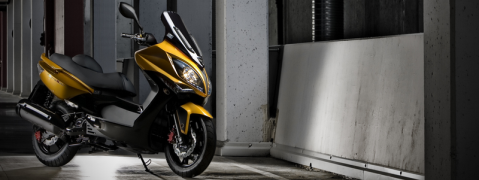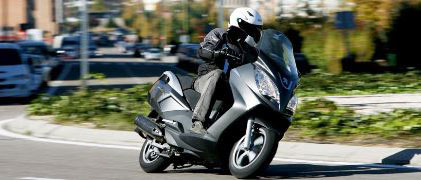 Kawasaki J300 - Service manual > Parts Location
Kawasaki J300 - Service manual > Parts Location
Front Wheel Rotation Sensor [A]
Front Wheel Rotation Sensor Rotor [B]
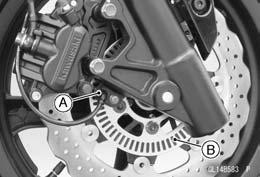
Rear Wheel Rotation Sensor [A]
Rear Wheel Rotation Sensor Rotor [B]
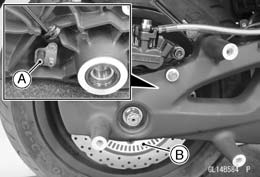
Yellow ABS Indicator Light [A]
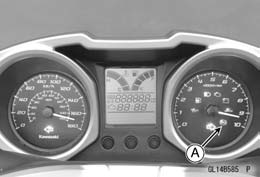
ABS Hydraulic Unit [A]
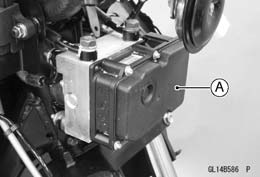
Fuse Box [A] (ABS Motor Relay Fuse 40 A, ABS Solenoid Valve Relay Fuse 25 A)
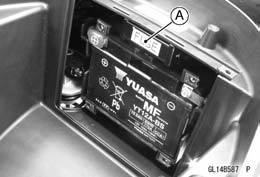
ABS System Wiring Diagram
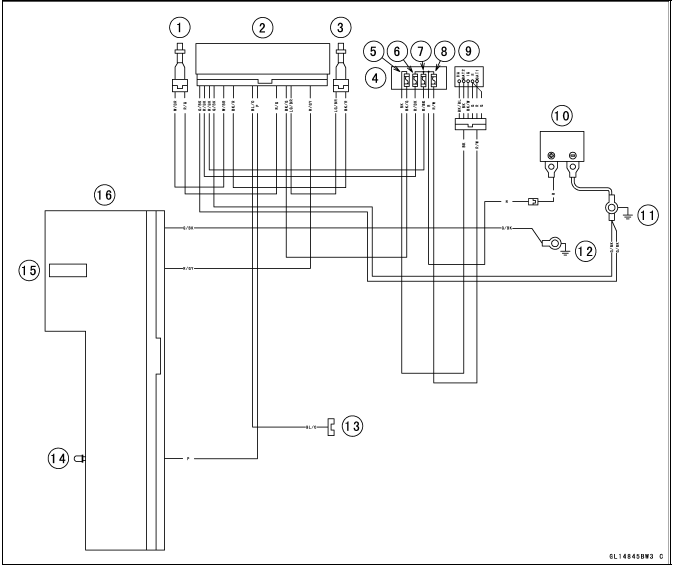
- Front Wheel Rotation Sensor
- ABS Hydraulic Unit
- Rear Wheel Rotation Sensor
- Fuse Box
- Ignition Fuse 10 A
- ABS Motor Relay Fuse 40 A
- ABS Solenoid Valve Relay Fuse 25 A
- Charging/ECU Fuse 30 A
- Ignition Switch
- Battery 12 V 10 Ah
- Engine Ground
- Frame Ground 1
- Self-Diagnosis System Connector
- Yellow ABS Indicator Light (LED)
- Speedometer
- Meter Unit
Color Codes:
BK: Black
BL: Blue
BR: Brown
CH: Chocolate
DG: Dark Green
G: Green
GY: Gray
LB: Light Blue
LG: Light Green
O: Orange
P: Pink
PU: Purple
R: Red
V: Violet
W: White
Y: Yellow
ABS Hydraulic Unit Terminal Names
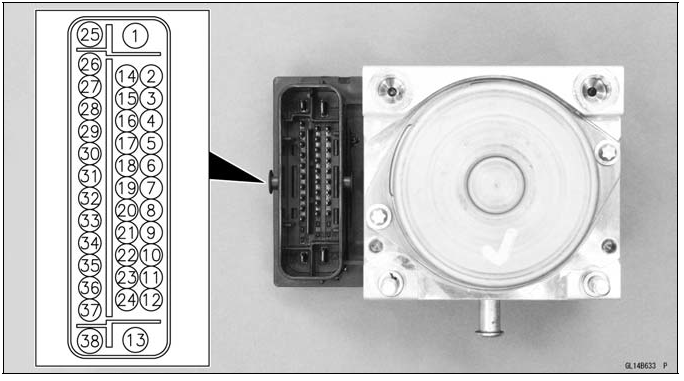
- Power Supply to ABS Motor Relay: R/BK
- Unused
- Unused
- Yellow ABS Indicator Light (LED): P
- Unused
- Unused
- Unused
- Unused
- Unused
- Unused
- Unused
- Unused
- Ground to Motor: G/BK
- Unused
- Unused
- Signal to Speedometer: R/GY
- Self-Diagnosis System Terminal: BL/O
- Unused
- Unused
- Power Supply to Rear Wheel Rotation Sensor: LG/BR
- Power Supply to Front Wheel Rotation Sensor: R/G
- Front Wheel Rotation Sensor Signal Output: W/BR
- Unused
- Unused
- Power Supply to ABS Solenoid Valve Relay: R/BK
- Unused
- Unused
- Unused
- Unused
- Unused
- RearWheel Rotation Sensor Signal Output: BK/R
- Power Supply: BK/G
- Unused
- Unused
- Unused
- Unused
- Unused
- Ground: G/BK
See also:
 Kawasaki J300 - Service manual > ABS Servicing Precautions
Kawasaki J300 - Service manual > ABS Servicing Precautions
There are a number of important precautions that should be followed servicing the ABS system. This ABS system is designed to be used with a 12 V sealed battery as its power source. Do not use any other battery except for a 12 V sealed battery as a power source. Do not reverse the battery cable connections. This will damage the ABS hydraulic unit. To prevent damage to the ABS parts, do not disconnect the battery cables or any other electrical connections when the ignition switch is on or while the engine is running. Take care not to short the leads that are directly connected to the battery positive (+) terminal to the chassis ground. Do not turn the ignition switch on while any of the ABS electrical connectors are disconnected. Do not spray water on the electrical parts, ABS parts, connectors, leads and wiring. If a transceiver is installed on the motorcycle, make sure that the operation of the ABS system is not influenced by electric wave radiated from the antenna. Locate the antenna as far as possible away from the ABS hydraulic unit. Whenever the ABS electrical connections are to be disconnected, first turn off the ignition switch. The ABS parts should never be struck sharply, as with a hammer, or allowed to fall on a hard surface. Such a shock to the parts can damage them. The ABS parts cannot be disassembled. Even if a fault is found, do not try to disassemble and repair the ABS parts, replace it. The ABS has many brake lines, pipes, and leads. And the ABS cannot detect problems with the conventional braking system (brake disc wear, unevenly worn brake pad, and other mechanical faults). To prevent trouble, check the brake lines and pipes for correct routing and connection, the wiring for correct routing, and the brakes for proper braking power. Be sure to check for fluid leakage, and bleed the brake line thoroughly.




